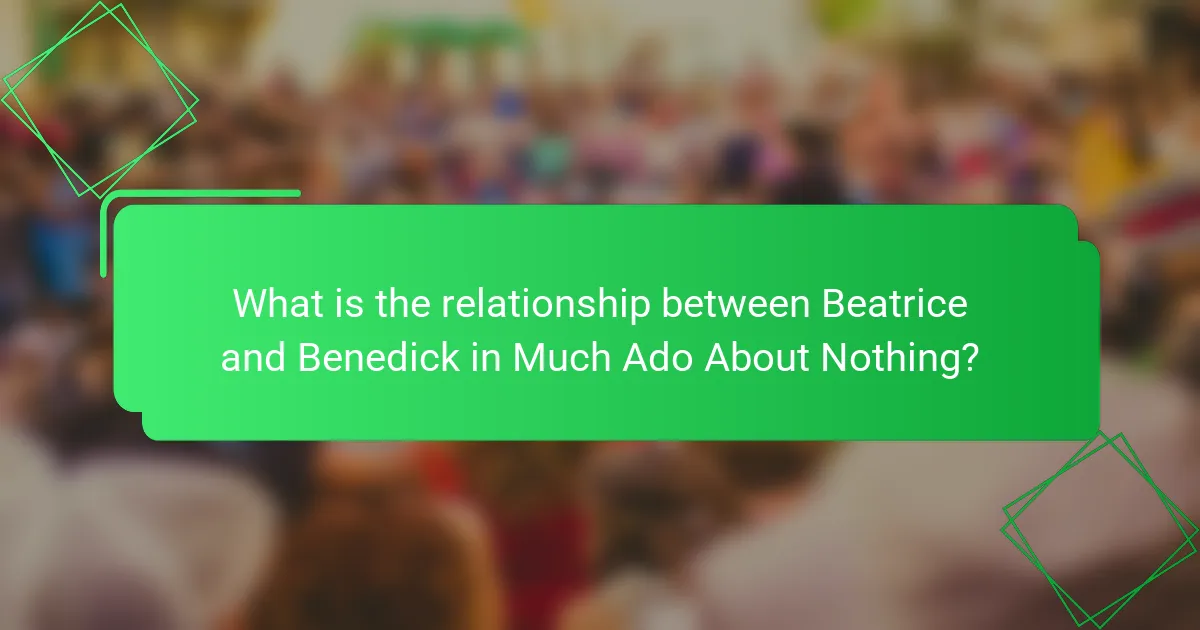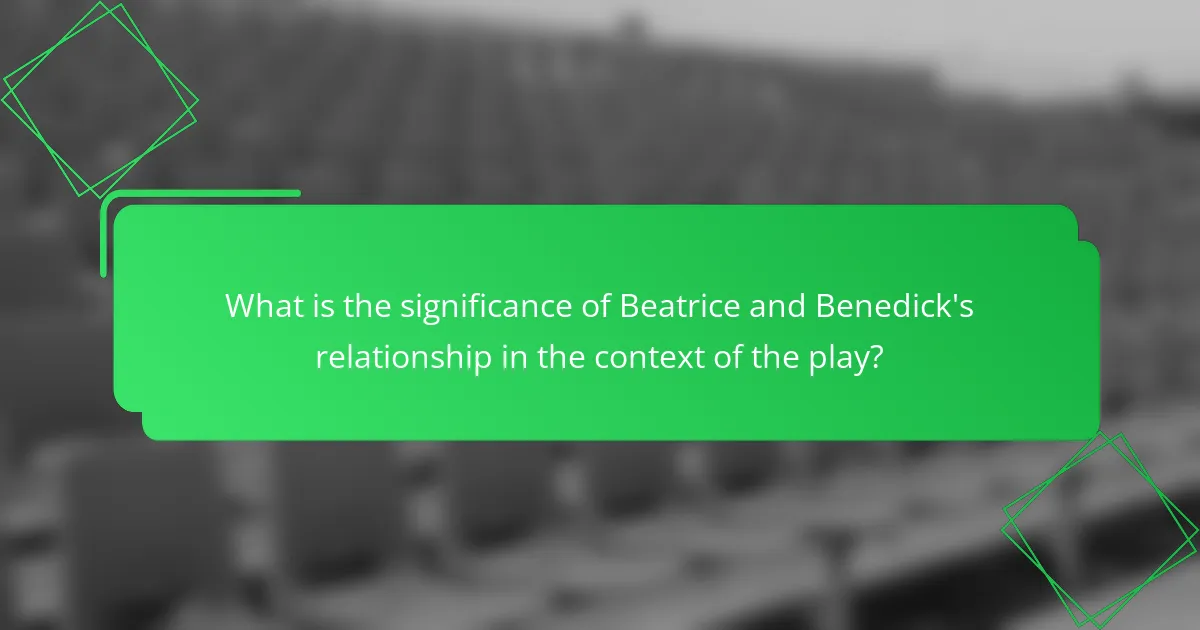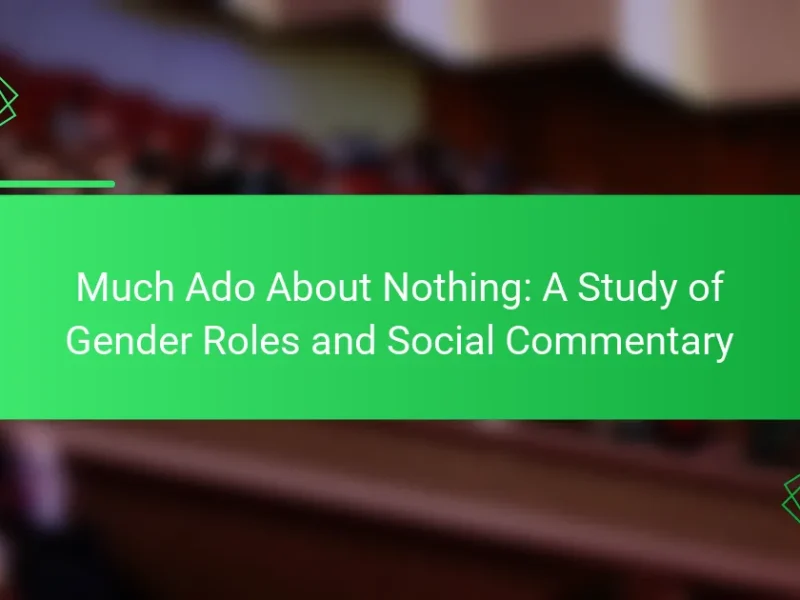
What is the relationship between Beatrice and Benedick in Much Ado About Nothing?
Beatrice and Benedick have a complex romantic relationship in Much Ado About Nothing. They engage in witty banter and verbal sparring throughout the play. This dynamic reflects their mutual attraction and underlying affection. Both characters initially deny their feelings, presenting themselves as disinterested in love. However, their interactions reveal a deeper connection. They are ultimately tricked into acknowledging their love for each other. This transformation showcases their growth and vulnerability. Their relationship evolves from playful antagonism to genuine romance by the play’s conclusion. The resolution of their conflict highlights the themes of love and misunderstandings in the narrative.
How do Beatrice and Benedick’s interactions reflect their personalities?
Beatrice and Benedick’s interactions reveal their witty and combative personalities. Both characters engage in sharp banter, showcasing their intelligence and quick thinking. Their exchanges often include playful insults, reflecting their mutual respect and attraction. This dynamic highlights their reluctance to show vulnerability. Beatrice’s assertiveness contrasts with Benedick’s more reserved nature, yet both are independent and strong-willed. Their verbal sparring serves as a defense mechanism against emotional connection. Ultimately, their interactions illustrate a complex relationship built on both rivalry and affection.
What are the key traits of Beatrice that influence her relationship with Benedick?
Beatrice’s key traits include her wit, independence, and strong will. Her sharp intellect allows her to engage in clever banter with Benedick. This wit creates a playful tension that defines their relationship. Beatrice’s independence makes her resistant to societal expectations of marriage. She values her autonomy, which challenges Benedick’s views on love. Additionally, her strong will enables her to confront Benedick directly. This directness fosters honesty between them. Ultimately, these traits create a dynamic relationship that evolves throughout the play.
How does Benedick’s character complement or contrast with Beatrice’s?
Benedick’s character contrasts with Beatrice’s through their differing approaches to love and relationships. Benedick initially expresses a disdain for marriage and romantic entanglements. He often engages in witty banter and displays a lighthearted attitude toward love. In contrast, Beatrice is more outspoken and assertive about her feelings. She challenges societal norms regarding women and love. Both characters share a sharp wit, which creates a complementary dynamic in their interactions. Their verbal sparring highlights their intelligence and mutual attraction. Ultimately, their contrasting views on love evolve throughout the play, leading to a deeper understanding and acceptance of each other. This evolution reinforces the theme of love’s transformative power in “Much Ado About Nothing.”
What themes are explored through Beatrice and Benedick’s relationship?
Beatrice and Benedick’s relationship explores themes of love, wit, and societal expectations. Their banter highlights the theme of love as both playful and serious. They challenge traditional notions of romance through their witty exchanges. Their relationship also examines the theme of individuality versus conformity. Both characters resist societal pressures to marry. This resistance emphasizes their desire for personal autonomy. Additionally, the theme of transformation is evident as their relationship evolves from conflict to mutual affection. Their journey reflects the complexities of love and the impact of communication.
How does the theme of love manifest in their dynamic?
The theme of love manifests in Beatrice and Benedick’s dynamic through their witty banter and mutual teasing. Their interactions are filled with sharp dialogue that reveals deep affection. This playful exchange often masks their true feelings. Both characters display a reluctance to admit their love due to pride. However, their vulnerability becomes evident as the story progresses. External influences, such as their friends’ schemes, ultimately bring their feelings to the forefront. Their eventual confession of love signifies a transformation in their relationship. This evolution showcases love’s complexity in the face of conflict and misunderstanding.
What role does wit and banter play in their interactions?
Wit and banter serve as a critical mechanism for Beatrice and Benedick’s interactions. Their exchanges reflect a playful yet profound connection. This verbal sparring allows them to express affection while maintaining a facade of independence. Their clever repartee reveals underlying emotions and vulnerabilities. It also highlights their mutual intelligence and compatibility. This dynamic creates tension and keeps the audience engaged. The wit serves to challenge societal norms regarding love and courtship. Ultimately, their banter deepens their relationship, transforming rivalry into romance.

What are the pivotal moments in Beatrice and Benedick’s relationship?
Beatrice and Benedick’s relationship experiences several pivotal moments throughout “Much Ado About Nothing.” Their initial banter establishes a foundation of wit and mutual disdain. This playful conflict highlights their chemistry and sets the stage for deeper feelings. The first significant moment occurs when they overhear conversations about each other’s affections. This revelation sparks a transformation in their relationship, moving from antagonism to romantic interest.
Another crucial moment is when Benedick defends Beatrice’s honor after Claudio publicly shames her cousin, Hero. This act signifies Benedick’s commitment and willingness to stand by Beatrice. Additionally, Beatrice’s request for Benedick to kill Claudio further illustrates her passionate nature and their emotional connection.
The climax of their relationship occurs during their private conversations, where they express vulnerability and love for one another. Their mutual confessions solidify their bond, marking the transition from playful sparring to genuine affection. These moments collectively shape the evolution of Beatrice and Benedick’s relationship, showcasing their growth and compatibility.
How does their relationship evolve throughout the play?
Beatrice and Benedick’s relationship evolves from witty banter and mutual disdain to love and commitment. Initially, they engage in sharp-tongued exchanges, showcasing their independence. Their interactions reveal a playful yet adversarial dynamic. As the play progresses, external influences, such as their friends’ schemes, lead them to reconsider their feelings. They begin to express vulnerability and deeper emotions. The turning point occurs when they overhear their friends discussing each other’s love for them. This revelation prompts both characters to confront their true feelings. Ultimately, Beatrice and Benedick’s relationship culminates in a mutual declaration of love. Their journey reflects a transformation from skepticism to genuine affection, highlighting themes of love and reconciliation.
What events trigger changes in their feelings for each other?
Beatrice and Benedick’s feelings for each other change due to several key events. Their initial banter reflects mutual disdain. However, overhearing conversations about each other’s love leads to shifts in their emotions. Beatrice’s reaction to Benedick’s supposed affection reveals her vulnerability. Benedick’s willingness to challenge Claudio for Beatrice signifies his deepening feelings. The masquerade ball also serves as a catalyst, allowing them to express hidden emotions. These events highlight the complexity of their relationship and the evolution of their feelings.
How does the influence of other characters affect their relationship?
The influence of other characters significantly affects Beatrice and Benedick’s relationship in “Much Ado About Nothing.” Their relationship evolves through the manipulations and schemes of friends. Characters like Claudio and Hero orchestrate events that lead to misunderstandings. For instance, they stage conversations to provoke Beatrice and Benedick’s feelings for each other. This external influence creates tension and comedic situations. The interactions with other characters serve as catalysts for their eventual union. Ultimately, these influences shape their perceptions and actions towards one another. This dynamic illustrates how external forces can impact personal relationships.
What misunderstandings occur between Beatrice and Benedick?
Beatrice and Benedick misunderstand each other’s feelings due to their witty banter. They both pretend to dislike each other while secretly harboring affection. This leads to confusion about their true emotions. Friends deceive them into believing the other is in love. They overhear conversations that misrepresent each other’s intentions. Benedick believes Beatrice is scornful, while Beatrice thinks Benedick is insincere. These misunderstandings create tension and delay their relationship development. Ultimately, clarity comes only after they confront their true feelings.
How do these misunderstandings contribute to the plot development?
Misunderstandings between Beatrice and Benedick significantly drive the plot development in “Much Ado About Nothing.” Their witty banter and misinterpretations create tension and conflict. These misunderstandings lead to comedic situations that engage the audience. For instance, Benedick believes Beatrice harbors disdain for him, which complicates their relationship. Beatrice, on the other hand, is misled into thinking Benedick is indifferent to her feelings. This dynamic propels the narrative forward. The misunderstandings also serve as a catalyst for their eventual reconciliation. Ultimately, these plot devices highlight themes of love and communication.
What lessons do Beatrice and Benedick learn from these misunderstandings?
Beatrice and Benedick learn the importance of communication and vulnerability from their misunderstandings. Their initial banter masks deeper feelings of love and affection. Misinterpretations lead to confusion and emotional distance. They realize that pride can hinder genuine connection. The misunderstandings ultimately prompt them to confront their true feelings. This leads to a more honest and open relationship. They learn that acknowledging emotions is crucial for intimacy. Their journey highlights the need for clarity in love.

What is the significance of Beatrice and Benedick’s relationship in the context of the play?
Beatrice and Benedick’s relationship is significant as it embodies the theme of love’s complexity in “Much Ado About Nothing.” Their witty banter and mutual disdain evolve into genuine affection. This transformation highlights the play’s exploration of love beyond superficial attraction. Their relationship contrasts with other couples, emphasizing individuality within romance. Beatrice and Benedick challenge societal norms, showcasing feminist ideals through their independence. Their eventual union symbolizes the reconciliation of opposing views on love. Their dynamic serves as a comedic counterpoint to the darker themes of deception and betrayal present in the play. Overall, their relationship enriches the narrative by illustrating the multifaceted nature of love.
How does their relationship contrast with other couples in the play?
Beatrice and Benedick’s relationship contrasts with other couples in “Much Ado About Nothing” through its foundation of wit and mutual respect. Unlike Claudio and Hero, whose relationship is marked by deception and misunderstanding, Beatrice and Benedick engage in playful banter that highlights their intelligence. Their dynamic is characterized by independence, as both characters initially resist romantic commitment. This contrasts with the more traditional and submissive roles seen in Hero, who conforms to societal expectations. Beatrice and Benedick’s eventual union is based on genuine affection rather than external pressures. Their relationship evolves through honest communication, unlike the secrecy that plagues Claudio and Hero’s romance. This distinction emphasizes the theme of love as a partnership built on equality and understanding.
What does their relationship reveal about societal expectations of love?
Beatrice and Benedick’s relationship reveals that societal expectations of love often prioritize wit and banter over traditional romantic expressions. Their dynamic showcases a challenge to conventional norms of courtship. They engage in verbal sparring, which highlights their intellectual compatibility. This relationship suggests that love can thrive outside of societal conventions. It also reflects the notion that love can be playful rather than purely serious. Their eventual union signifies a reconciliation between personal desires and societal expectations. This aligns with the Elizabethan context, where marriage was often viewed as a social contract. Ultimately, their relationship illustrates that love can adapt to individual personalities while still acknowledging societal norms.
How does their dynamic contribute to the comedic elements of the play?
Beatrice and Benedick’s dynamic contributes significantly to the comedic elements of “Much Ado About Nothing.” Their witty banter and verbal sparring create humor through clever wordplay. This constant teasing highlights their mutual attraction while showcasing their reluctance to admit feelings. Their interactions often lead to misunderstandings, which further amplify the comedic tension. Additionally, their playful challenges to each other’s intelligence keep the audience engaged. The contrast between their public personas and private affections adds layers to the humor. Their eventual reconciliation is comedic relief, transforming their rivalry into romance. This shift underscores the play’s themes of love and deception, enhancing the overall comedic effect.
What can we learn from Beatrice and Benedick’s relationship dynamics?
Beatrice and Benedick’s relationship dynamics teach us about the complexity of love and communication. Their witty banter highlights how humor can mask deeper feelings. They initially present themselves as antagonistic, using sarcasm to deflect vulnerability. This dynamic showcases the tension between societal expectations and personal desires. Their eventual reconciliation reveals the importance of honesty in relationships. Their journey emphasizes that love can evolve through self-discovery and mutual respect. Ultimately, their relationship illustrates that true connection often requires overcoming pride and embracing vulnerability.
How can their witty banter be applied to modern relationships?
Witty banter can enhance modern relationships by fostering communication and intimacy. This playful exchange creates a unique bond between partners. It encourages honesty and vulnerability in discussions. Humor can diffuse tension during conflicts, making resolutions easier. Studies show that couples who share laughter report higher relationship satisfaction. Engaging in witty banter also promotes emotional connection and understanding. This dynamic can help partners navigate challenges together. Overall, incorporating playful dialogue strengthens the foundation of modern relationships.
What insights about love and partnership can be drawn from their journey?
Beatrice and Benedick’s journey reveals that love often involves overcoming pride and misunderstanding. Their initial banter masks deeper feelings, illustrating how humor can both connect and create distance. As they confront their vulnerabilities, they demonstrate that honesty is essential in partnership. Their eventual reconciliation emphasizes that love requires effort and willingness to change. The evolution of their relationship shows that true partnership thrives on mutual respect and support. Their journey highlights that love can flourish even amidst conflict and challenges. Ultimately, their story teaches that love is a dynamic process, shaped by growth and communication.
The main entity of this article is the relationship dynamics between Beatrice and Benedick in Shakespeare’s “Much Ado About Nothing.” The article provides a detailed analysis of their complex romantic relationship, highlighting their witty banter, mutual attraction, and eventual transformation from playful antagonism to genuine affection. Key aspects discussed include their contrasting personalities, the influence of societal expectations, pivotal moments that trigger changes in their feelings, and the comedic elements that arise from their interactions. Additionally, the article explores the themes of love, communication, and individuality as they navigate misunderstandings and external influences throughout the play.


